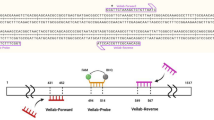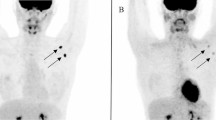Abstract
MALDI-TOF mass spectrometry (MS) may be used as a rapid typing method for nosocomial pathogens. Here, we evaluated MALDI-TOF MS for discrimination of hospital outbreak-related clusters of Serratia marcescens and carbapenemase-producing Citrobacter freundii. Thirty-three S. marcescens isolates collected from neonatal intensive care unit (NICU) patients, and 23 C. freundii isolates including VIM-positive isolates from a hospital colonization outbreak were measured by Vitek MS. Consensus spectra of each isolate were clustered using SARAMIS software. Genotyping was performed by whole-genome sequencing (WGS). First, a set of 21 S. marcescens isolates from 2014 with seven genotypes including three monoclonal clusters was used for the evaluation of MALDI-TOF typing. MS clustering was largely in agreement with genotyping results when the similarity cut-off for clonal identity was set on 90%. MALDI-TOF cluster analysis was then investigated for the surveillance of S. marcescens in the NICU in 2017 and demonstrated the introduction of new strains into the hospital and nosocomial transmissions. MS analysis of the C. freundii outbreak in 2016 revealed a monoclonal cluster of VIM-positive isolates and the separation of epidemiologically non-related VIM-positive and negative isolates. Two additional VIM-positive Citrobacter isolates from food samples were closely related to the large monoclonal cluster. WGS confirmed the MS results. MALDI-TOF MS may be used as a first-line typing tool for S. marcescens and C. freundii to detect transmission events in the hospital because isolates of an identical WGS type were grouped into the same MS cluster.




Similar content being viewed by others
References
Logan LK, Weinstein RA (2017) The epidemiology of carbapenem-resistant Enterobacteriaceae: the impact and evolution of a global menace. J Infect Dis 215(Suppl 1):S28–S36. https://doi.org/10.1093/infdis/jiw282
Goering RV, Köck R, Grundmann H, Werner G, Friedrich AW, on behalf of the ESCMID study group for epidemiological markers (ESGEM) (2013) From theory to practice: molecular strain typing for the clinical and public health setting. Euro Surveill 18:20383. https://doi.org/10.2807/ese.18.04.20383-en
Dawczynski K, Proquitté H, Roedel J, Edel B, Pfeifer Y, Hoyer H, Dobermann H, Hagel S, Pletz MW (2016) Intensified colonization screening according to the recommendations of the German commission for hospital hygiene and infectious disease prevention (KRINKO): identification and containment of a Serratia marcescens outbreak in the neonatal intensive care unit, Jena, Germany, 2013-2014. Infection 44:739–746. https://doi.org/10.1007/s15010-016-0922-y
Gastmeier P (2014) Serratia marcescens: an outbreak experience. Front Microbiol 5:81. https://doi.org/10.3389/fmicb.2014.00081
Kluytmans-van den Bergh MF, Rossen JW, Bruijning-Verhagen PC, Bonten MJ, Friedrich AW, Vandenbroucke-Grauls CM, Willems RJ, Kluytmans JA (2016) Whole-genome multilocus sequence typing of extended-spectrum-beta-lacatamase-producing Enterobacteriaceae. J Clin Microbiol 54:2919–2927. https://doi.org/10.1128/JCM.01648-16
Sabat AJ, Budimir A, Nashev D, Sá-Leão R, van Dijl JM, Laurent F, Grundmann H, Friedrich AW, ESCMID Study Group of Epidemiological Markers (ESGEM) (2013) Overview of molecular typing methods for outbreak detection and epidemiological surveillance. Euro Surveill 18:20380. https://doi.org/10.2807/ese.18.04.20380-en
Mellmann A, Bletz S, Böking T, Kipp F, Becker K, Schultes A, Prior K, Harmsen D (2016) Real-time genome sequencing of resistant bacteria provides precision infection control in an institutional setting. J Clin Microbiol 54:2874–2881. https://doi.org/10.1128/JCM.00790-16
Sauget M, Valot B, Bertrand X, Hocquet D (2016) Can MALDI-TOF mass spectrometry reasonably type bacteria? Trends Microbiol 25:447–455. https://doi.org/10.1016/j.tim.2016.12.006
Khennouchi NC, Loucif L, Boutefnouchet N, Allag H, Rolain JM (2015) MALDI-TOF MS as a tool to detect a nosocomial outbreak of extended-spectrum-β-lactamase- and ArmA methyltransferase-producing Enterobacter cloacae clinical isolates in Algeria. Antimicrob Agents Chemother 59:6477–6483. https://doi.org/10.1128/AAC.00615-15
Rodrigues C, Novais Â, Sousa C, Ramos H, Coque TM, Cantón R, Lopes JA, Peixe L (2017) Elucidating constraints for differentiation of major human Klebsiella pneumoniae clones using MALDI-TOF MS. Eur J Clin Microbiol Infect Dis 36:379–386. https://doi.org/10.1007/s10096-016-2812-8
Sandrin TR, Goldstein JE, Schumaker S (2013) MALDI TOF MS profiling of bacteria at the strain level: a review. Mass Spectrom Rev 32:188–217. https://doi.org/10.1002/mas.21359
Veenemans J, Welker M, van Belkum A, Saccomani MC, Girard V, Pettersson A, Verhulst C, Kluytmans-Vandenbergh M, Kluytmans J (2016) Comparison of MALDI-TOF MS and AFLP for strain typing of ESBL-producing Escherichia coli. Eur J Clin Microbiol Infect Dis 35:829–838. https://doi.org/10.1007/s10096-016-2604-1
Oberle M, Wohlwend N, Jonas D, Maurer FP, Jost G, Tschudin-Sutter S, Vranckx K, Egli A (2016) The technical and biological reproducibility of matrix-assisted laser desorption ionization-time of flight mass spectrometry (MALDI-TOF MS) based typing: employment of bioinformatics in a multicenter study. PLoS One 11:e0164260. https://doi.org/10.1371/journal.pone.0164260
Willems S, Kampmeier S, Bletz S, Kossow A, Köck R, Kipp F, Mellmann A (2016) Whole-genome sequencing elucidates epidemiology of nosocomial clusters of Acinetobacter baumannii. J Clin Microbiol 54:2391–2394. https://doi.org/10.1128/JCM.00721-16
van Belkum A, Tassios PT, Dijkshoorn L, Haeggman S, Cookson B, Fry NK, Fussing V, Green J, Feil E, Gerner-Schmidt P, Brisse S, Struelens M, for the European Society of Clinical Microbiology and Infectious Diseases (ESCMID) Study Group on Epidemiological Markers (ESGEM) (2007) Guidelines for the validation and application of typing methods for use in bacterial epidemiology. Clin Microbiol Infect 13(Suppl. 3):1–46. https://doi.org/10.1111/j.1469-0691.2007.01786.x
Carriço JA, Silva-Costa C, Melo-Cristino J, Pinto FR, de Lencastre H, Almeida JS, Ramirez M (2006) Illustration of a common framework for relating multiple typing methods by application to macrolide-resistant Streptococcus pyogenes. J Clin Microbiol 44:2524–2532. https://doi.org/10.1128/JCM.02536-05
Water V, Zlosnik JEA, Yau YCW, Speert DP, Aaron SD, Guttman DS (2012) Comparison of three typing methods for Pseudomonas aeruginosa isolates from patients with cystic fibrosis. Eur J Clin Microbiol Infect Dis 31:3341–3350. https://doi.org/10.1007/s10096-012-1701-z
Mellmann A, Andersen PS, Bletz S, Friedrich AW, Kohl TA, Lilje B, Niemann S, Prior K, Rossen JW, Harmsen D (2017) High interlaboratory reproducibility and accuracy of next-generation-sequencing-based bacterial genotyping in a ring trial. J Clin Microbiol 55:908–913. https://doi.org/10.1128/JCM.02242-16
Koren S, Walenz BP, Berlin K, Miller JR, Phillippy AM (2017) Canu: scalable and accurate long-read assembly via adaptive k-mer weighting and repeat separation. Genome Res 27:722–736. https://doi.org/10.1101/gr.215087.116
Alikhan NF, Petty NK, Ben Zakour NL, Beatson SA (2011) BLAST Ring Image Generator (BRIG): simple prokaryote genome comparisons. BMC Genomics 12:402. https://doi.org/10.1186/1471-2164-12-402
Pletz MW, Wollny A, Dobermann UH, Rödel J, Neubauer S, Stein C, Brandt, Hartung A, Mellmann A, Trommer S, Edel B, Patchev V, Makarewicz O, Maschmann J (2018) A nosocomial foodborne outbreak of a VIM carbapenemase-expressing Citrobacter freundii. Clin Infect Dis. https://doi.org/10.1093/cid/ciy034
Wick RR, Judd LM, Gorrie CL, Holt KE (2017) Completing bacterial genome assemblies with multiplex MinION sequencing. Microbe Genom 3:e000132. https://doi.org/10.1099/mgen.0.000132
Ivády B, Szabó D, Damjanova I, Pataki M, Szabó M, Kenesei É (2014) Recurrent outbreaks of Serratia marcescens among neonates and infants at a pediatric department: an outbreak analysis. Infection 42:891–898. https://doi.org/10.1007/s15010-014-0654-9
Samuelson A, Isaksson B, Hanberger H, Olhager E (2014) Late-onset neonatal sepsis, risk factors and interventions: an analysis of recurrent outbreaks of Serratia marcescens 2006-2011. J Hosp Infect 86:57–63. https://doi.org/10.1016/j.jhin.2013.09.017
Martineau C, Li X, Lalancette C, Perreault T, Fournier E, Tremblay J, Gonzales M, Yergeau É, Quach C (2018) Serratia marcescens outbreak in a neonatal intensive care unit: new insights from next-generation sequencing applications. J Clin Microbiol 56:e00235–e00218. https://doi.org/10.1128/JCM.00235-18
Gaibani P, Ambretti S, Farruggia P, Bua G, Berlingeri A, Tamburini MV, Gordovana M, Guerra L, Mazzetti M, Roncarati G, Tenace C, Moro ML, Gagliotti C, Landini MP, Sambri V (2013) Outbreak of Citrobacter freundii carrying VIM-1 in an Italian hospital, identified during the carbapenemases screening actions, June 2012. Int J Infect Dis 17:e714–e717. https://doi.org/10.1016/j.ijid.2013.02.007
Hammerum AM, Hansen F, Nielsen HL, Jakobsen L, Stegger M, Andersen PS, Jensen P, Nielsen TK, Hansen LH, Hasman H, Fuglsang-Damgaard D (2016) Use of WGS for investigation of a long-term NDM-1-producing Citrobacter freundii outbreak and secondary in vivo spread of bla NDM-1 to Escherichia coli, Klebsiella pneumoniae and Klebsiella oxytoca. J Antimicrob Chemother 71:3117–3124. https://doi.org/10.1093/jac/dkw289
Egli A, Tschudin-Sutter S, Oberle M, Goldenberger D, Frei R, Widmer AF (2015) Matrix-assisted laser desorption/ionization time off light mass-spectrometry (MALDI-TOF MS) based typing of extended-spectrum β-lactamase producing E. coli – a novel tool for real-time outbreak investigation. PLoS One 10:e0120624. https://doi.org/10.1371/journal.pone.0120624
Sachse S, Bresan S, Erhard M, Edel B, Pfister W, Saupe A, Rödel J (2014) Comparison of multilocus sequence typing, RAPD, and MALDI-TOF mass spectrometry for typing of β-lactam-resistant Klebsiella pneumoniae. Diagn Microbiol Infect Dis 80:267–271. https://doi.org/10.1016/j.diagmicrobio.2014.09.005
Spinali S, van Belkum A, Goering RV, Girard V, Welker M, Van Nuenen M, Pincus DH, Arsac M, Durand G (2015) Microbial typing by matrix-assisted laser desorption ionization-time of flight mass spectrometry: do we need guidance for data interpretation? J Clin Microbiol 53:760–765. https://doi.org/10.1128/JCM.01635-14
Acknowledgements
We thank Sabine Trommer (Public Health Office Jena), Helke Dobermann, Mathias Pletz (Jena University Hospital), and their team of hygiene professionals for the excellent work during the C. freundii outbreak in 2016. We thank Wolfgang Stöckigt, Dietmar Schönherr, and Friedrich Dübler (bioMérieux) for technical support for the Vitek MS machine. We thank Ursula Keckvoet, Isabell Höfig, and Stefan Bletz (Institute of Hygiene, University Hospital Münster) for their skillful technical assistance during WGS.
Funding
This work was supported by a grant from the German Federal Ministry of Education and Research (BMBF, 13N13890).
Author information
Authors and Affiliations
Corresponding author
Ethics declarations
Ethical approval
Because in this work a method for subtyping bacterial isolates was developed and the paper contains no patient data, research ethics committee approval was not required.
Conflict of interest
The authors declare that there are no conflicts of interest.
Additional information
Publisher’s note
Springer Nature remains neutral with regard to jurisdictional claims in published maps and institutional affiliations.
Electronic supplementary material
ESM 1
(XLSX 428 kb)
Rights and permissions
About this article
Cite this article
Rödel, J., Mellmann, A., Stein, C. et al. Use of MALDI-TOF mass spectrometry to detect nosocomial outbreaks of Serratia marcescens and Citrobacter freundii. Eur J Clin Microbiol Infect Dis 38, 581–591 (2019). https://doi.org/10.1007/s10096-018-03462-2
Received:
Accepted:
Published:
Issue Date:
DOI: https://doi.org/10.1007/s10096-018-03462-2




